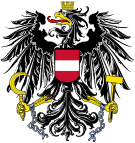| |||||||||||||||||||||||||||||||||||||||||
All 183 seats in the National Council 92 seats needed for a majority | |||||||||||||||||||||||||||||||||||||||||
|---|---|---|---|---|---|---|---|---|---|---|---|---|---|---|---|---|---|---|---|---|---|---|---|---|---|---|---|---|---|---|---|---|---|---|---|---|---|---|---|---|---|
| Turnout | 80.27% | ||||||||||||||||||||||||||||||||||||||||
| |||||||||||||||||||||||||||||||||||||||||
| |||||||||||||||||||||||||||||||||||||||||
| This article is part of a series on the |
| Politics of Austria |
|---|
 |
Parliamentary elections were held in Austria on 17 October 1920, [1] although they were not held in Carinthia until 19 June 1921 and in Burgenland until 18 June 1922. [2] They were the first regular elections held after a permanent constitution was promulgated two weeks earlier.
The result was a victory for the Christian Social Party, which won 85 of the 183 seats. [3] Voter turnout was 80%. [4]





